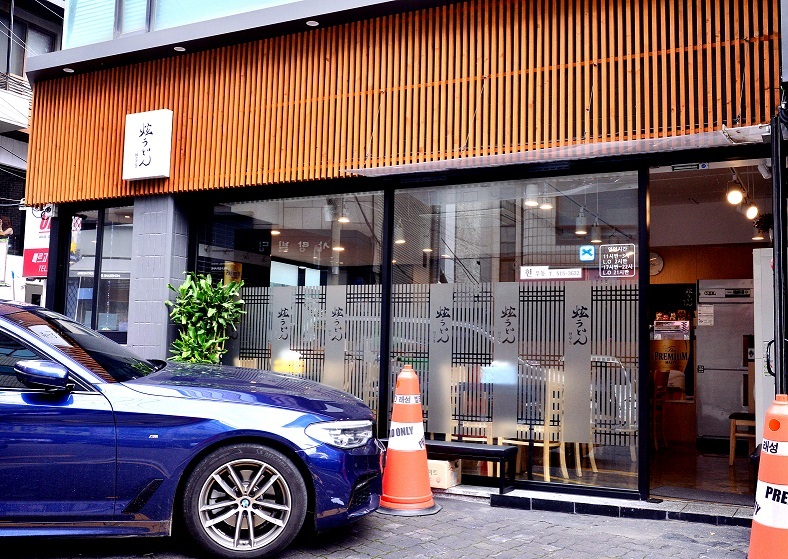Hyun Udon owner-chef Park Sang-hyun takes noodle making very seriously.
To ensure their freshness, Park and his team make the noodles twice a day, once in the morning and once in the evening.
His udon noodles are crafted with flour, sun-dried salt, vinegar and water.
The acidic nature of vinegar, according to Park, interacts with the gluten in the dough in a manner that helps him achieve the noodles he wants -- which are incredibly chewy and smooth.
After resting the dough twice, once for two hours and then again at a low temperature for at least 17 hours, the dough is rolled out and cut to very specific measurements.
The rectangular-shaped noodles are cut so that the widest surface measures 6.4 millimeters and the narrowest surface clocks in at 4 millimeters.
“These measurements affect the texture of the noodle,” Park, 36, explained.
The noodles are then boiled for exactly 16 minutes and 20 seconds before being immersed in cold water.
When served as a cold dish like bukkake udon, the noodles are then submerged a second time in ice water before being coiled into a glutinous, glossy heap in a bowl and topped with crisp, hot, freshly-fried tempura.
Hyun Udon serves a mean tempura bukkake.
While similar to zaru udon in that it is served cold, with bukkake one does not dip the noodles into a sauce, instead one pours a broth over the noodles to create a cool noodle soup.
“‘Bukkake’ means to ‘pour over,’” Park said, explaining why this dish is served with a small bottle of cool tsuyu broth.
A wedge of lemon, minced ginger and chopped green onion and a bottle of sesame seeds also accompany this dish.
Park recommends adding both the ginger and green onion and squeezing the lemon, grinding the sesame seeds and pouring the tsuyu over the noodles.
Park also recommends dunking the tempura into the tsuyu “to let the tempura soak up the broth.”
“That is why I fry the tempura so it blooms,” Park said, referring to the deliberately shaggy exterior of the batter-fried shrimp and vegetables, which he explains helps the tempura absorb the tsuyu.
How to enjoy Hyun Udon’s tempura bukkake udon:
 |
(Park Hyun-koo/The Korea Herald) |
1) Squeeze fresh lemon over noodles to add a citrusy flavor to the dish.
2) Add minced ginger and chopped green onions.
3) Grind sesame seeds over the noodles.
4) Pour all of the tsuyu broth over the noodles.
5) Mix together and enjoy.
The citrus punch of the lemon and the fragrant ginger blends beautifully with Hyun Udon’s umami tsuyu, which is made with a broth crafted from several varieties of dried fish, kombu, katsuobushi, soy sauce, sweet rice wine and sugar.
The springy, thick noodles go well with the fragrant, citrusy broth and rich tempura, adding a satisfying and refreshing heft to this summer-friendly dish.
While Hyun Udon’s tempura bukkake is a surefire option, there are two other variations of bukkake udon on the menu, including Park’s own favorite shrimp tempura and fried mochi version, along with two variations of zaru udon.
Park also revealed plans to add a summer-friendly, seasonal lemon udon to the menu this month.
For his lemon udon, noodles will be submerged in that dried fish, kombu and katsuoboshi broth, amped up with soy sauce, and topped with plenty of lemon slices and mizuna -- Japanese mustard greens.
“Now I want to release seasonal dishes a little bit at a time,” said Park of his future plans for Hyun Udon.
Before opening Hyun Udon over a year ago in Seoul’s Nonhyeon-dong, Park honed his udon-making skills at a prominent udon restaurant in Japan for three years before returning to Korea to work at two udon restaurants for another three years.
Last May, Park finally opened his own restaurant, christening it Hyun Udon, a nod to his first name, Sang-hyun, and also referencing one of the Chinese characters for “hyun,” which means “bright.”
“Because freshly made udon noodles are bright and shiny,” Park said.
Fans of Sanuki udon, a regional type of udon from Japan’s Kagawa Prefecture, will instantly recognize the style by the thickness of the noodles at Hyun Udon.
Park explained that the basic style of his udon is Sanuki by way of Osaka, which he describes as similar to traditional Sanuki udon with some differences in the texture of the noodles and the broth.
Hyun Udon
 |
(Park Hyun-koo/The Korea Herald) |
11-1 Nonhyeon-dong, Gangnam-gu, Seoul
(02) 515-3622
Open Mondays through Saturdays from 11:30 a.m. to 3 p.m., 5:30 p.m. to 10 p.m., closed Sundays
Cold udon dishes cost 8,000 won to 12,000 won, hot udon dishes cost 8,000 won to 13,000 won
By Jean Oh (
oh_jean@heraldcorp.com)








![[Today’s K-pop] Blackpink’s Jennie, Lisa invited to Coachella as solo acts](http://res.heraldm.com/phpwas/restmb_idxmake.php?idx=644&simg=/content/image/2024/11/21/20241121050099_0.jpg)
